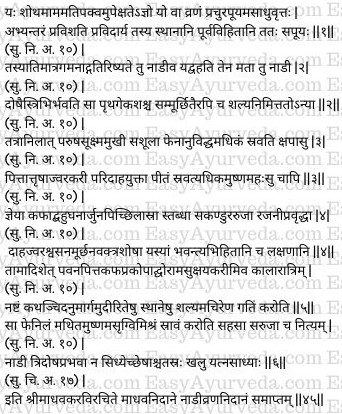Madhava Nidana Chapter 45 Nadivrana Nidanam
This article explains Madava nidana 45th chapter “Bhagna Nadivrana ”. Causes, pathology and symptoms of Nadivrana are explained in this chapter. Nadivrana is sinus wounds or deep wounds with a track.
Table of Contents
Nadivrana Nidana, Samprapti
Etiological Factors and Pathogenesis of Nadivrana
When the ignorant physician who cuts open an unripe swelling or delays draining of a fully ripened swelling (in which the pus has formed completely) or an unscrupulous physician who does not drain out the pus from an ulcer completely, the pus which has been formed makes way into the deeper tissues by making a sinus and piercing into the vrana sthanas (seats of ulcer like skin, muscles etc mentioned by Master Sushruta). (This leads to the formation of nadi vrana) (1).
Read – Nadivrana – Sinus: Types, Symptoms, Ayurvedic Treatment

Nadivrana Nirukti, Bheda
Definition of the word Nadivrana
Gati – Since there is excessive movement of pus inside the sinus it is called as gati. (gati = movement).
Nadivrana – Since it is in the form of a tube or hollow pipe (because of the formation of hollow passage or sinus) and carries pus in it, this condition is called as nadi vrana.

Types of nadivrana
Nadivrana is of five types, one from each of the three doshas (caused by single dosha predominance – vataja, pittaja and kaphaja), one from the combined vitiation of all the three doshas (tridoshaja, sannipataja) and the other one due to the presence of a foreign body (shalyaja). (2)
- Vataja Nadivrana
- Pittaja Nadivrana
- Kaphaja Nadivrana
- Sannipataja Nadivrana
- Shalyaja Nadivrana – caused by foreign bodies such as a sharp instrument
Read – Fistula In Ano Ayurvedic Understanding And Effective Treatment
Symptoms of types of nadivrana
Vataja Nadivrana – In this type, the nadi is rough, will have small orifice (opening), is painful, and will have exudation of frothy material especially during cold times and at night.
Pittaja Nadivrana – In this type, the person will have thirst, fever and burning sensation. The sinus will discharge yellowish material (exudates) especially during hot time i.e., daytime (midday).
Kaphaja Nadivrana – In this type, the discharge is copious, excessively thick, white and sticky. The ulcer is hard, has more itching and the pain increases during night time.
Tridoshaja Nadivrana – In this type, there is burning sensation, fever, difficulty in breathing, fainting (loss of consciousness), dryness of the mouth and all symptoms of doshaja nadivranas (vataja, pittaja and kaphaja) explained above mixed together. This condition is said to be fatal and should be considered similar to Kalaratri i.e., sister of God of death in terms of taking away life. (2-5)
Shalyaja Nadivrana
A foreign body somehow reaching and getting embedded and hidden in the skin, muscle and other seats of vrana (ulcer) will make way into the deeper tissues creating a passage (sinus) and quickly cause nadivrana. From this sinus there is exudation of frothy, as if churned, hot and blood mixed material spontaneously accompanied with pain. This is called as shalyaja nadivrana. (5)
Read – Charaka Vrana Chikitsa – 25th Chapter – Wounds, Ulcers
Symptoms of incurability of Nadivrana
Nadi Vrana (sinus ulcer) of the tridoṣhaja kind does not respond to treatment (it is incurable). The other four types of nadivrana can be treated with difficulty. (6)
Thus ends the chapter on Nadivrana Nidanam in Madhava Nidana text written by Acharya Madhavakara.










